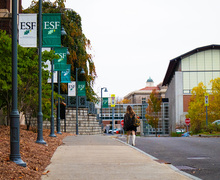SU to host crucial civil rights champion
For students today, going to class hardly equates to breaking the law.
But when an African-American student wanted to attend an all-white school 50 years ago, she challenged the law and changed it, through the famed Brown vs. Board of Education Supreme Court case.
That student, Linda Brown Thompson, will speak April 16 in Syracuse University’s Hendricks Chapel to help commemorate the 50th anniversary of the case, said Paula Johnson, law professor in the College of Law and co-chairwoman of the Brown 50th Commemoration Committee.
In the case, Thompson’s parents sued the board to allow her into an all-white Kansas school. The court unanimously declared that the denial of Thompson’s admittance was unconstitutional, and this decision ended the legal segregation of schools.
‘It was a landmark case for all of education,’ said Beth Ferri, associate professor of education and member of the Brown 50th Commemoration Committee. ‘It’s one that is still reverberating as we speak.’
A panel discussion in Hendricks Chapel will follow the speech, where Thompson, her sister Cheryl Brown Henderson and select SU faculty will discuss the impact and current issues relating to the case. Smaller discussion groups will also meet as part of the two-day commemoration, to learn about each other’s experiences and memories of the case, Johnson said.
‘What we want to have is a reflection that really extends across the many areas of our community,’ Johnson said. ‘It’s not solely an academic event. It’s something for the public at large, where everyone can contribute their insight and experience.’
Thompson lived close to an all-white high school in Topeka, Kansas, and passed it on her walk to her all-black high school. But officials at the white high school refused to admit her when her father tried to enroll her there.
The NAACP and 13 parents, including the Rev. Oliver Leon Brown, filed suit against the Board of Education in Topeka for prohibiting black children from white schools.
‘Their parents allowed them to be sort of revolutionaries,’ Ferri said.
The case moved through lower courts to the Supreme Court. Before the court made its decision on May 17, 1954, the ‘separate but equal’ facilities policy of the 1896 Plessy vs. Ferguson case had applied to public schools.
‘The U.S. Supreme Court unanimously struck down the legal principle in law, as well as in custom,’ Johnson said. ‘It was a watershed event in the U.S. at that time.’
The ruling set the standard for many other civil rights cases, Ferri said. Other cases, such as those involving students with disabilities, also declared that students could not be denied admission on any grounds.
‘This case was so significant because the influence of that decision began to reach out into other areas,’ Johnson said. ‘Employment, housing, all of these other things had to be opened up.’
But this commemoration event does not only mark a time to celebrate, Johnson said.
‘We can’t just herald the fact that the court made this decision when we look around see some of the same circumstances that existed in 1954 still around,’ Johnson said. ‘Now we need to ask more questions. As much promise as Brown held out, we can acknowledge that it has not been fully realized. How do we make the promise of Brown come true?’
‘We need to be rededicated to taking the steps necessary to making Brown more real, and not just a myth,’ Johnson added.
Thompson and Henderson’s speech, as well as the following discussions and panel, may help answer some of those questions.
‘I’m personally very interested to hear what she thinks of the progress we’ve made, and what do we have to celebrate and what do we have to work for,’ Ferri said.
Some people believe the speakers will help students place the case in a realistic context of their everyday lives and make them realize how the decision affected their educational experience.
‘It’s a good thing for her to come and educate us about it and increase our awareness of it,’ said Melissa Leighton, a senior surface pattern design major. ‘It’s something we’ve heard about, but didn’t have to experience ourselves.’
Published on January 25, 2004 at 12:00 pm





